今天云朵君和大家一起学习一个期末作业项目。
本文亮点:
- 项目流程完整,从数据预处理、特征工程、建模到预测
- 使用Pipline构建机器学习管道
- 使用optuna优化算法
- 数据完整、代码完整
背景
预测客户流失是机器学习在行业中的一种常见用例,特别是在金融和订阅服务领域。
流失率是指离开提供商的用户数量。它也可以指离开公司的员工(员工保留率)。
因此,银行客户流失(又称客户流失)是指客户停止与一家银行做生意或转向另一家银行。
数据
数据字典:
- Customer ID:每个客户的唯一标识符
- Surname:客户的姓氏
- Credit Score:代表客户信用评分的数值
- Geography:客户居住的国家/地区
- Gender:顾客的性别
- Age:顾客的年龄。
- Tenure:客户在该银行的服务年限
- Balance:客户的账户余额
- NumOfProducts:客户使用的银行产品数量(例如储蓄账户、信用卡)
- HasCrCard:客户是否拥有信用卡
- IsActiveMember:客户是否为活跃会员
- EstimatedSalary:客户的预计工资
- Exited:客户是否流失(目标变量)
目标
这是一个经典的二元分类问题。
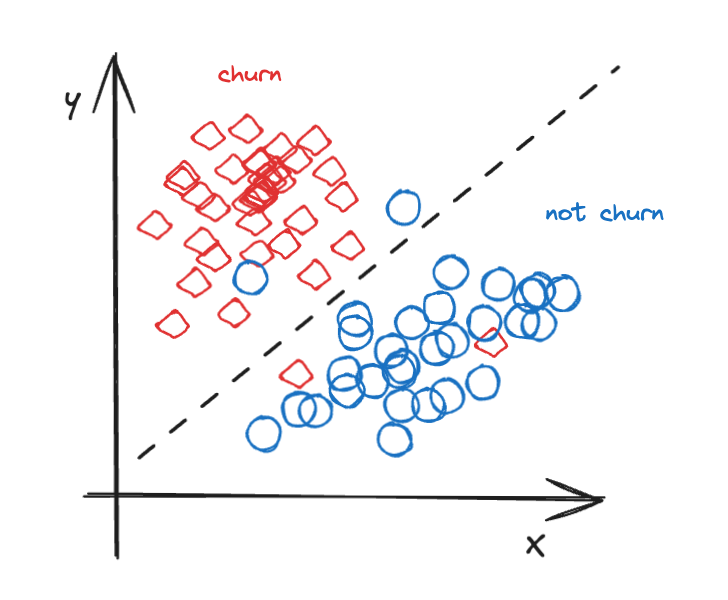 图片
图片
在二元问题中,你必须猜测一个示例是否应该归类到特定类别(通常是正类 (1) 和负类 (0)。在本例中,churn 是正类。
预测一个新的y = 0或是y = 1一项常见的任务,但在很多情况下,你必须提供一个概率,特别是在医疗应用中,你必须对不同选项中的积极预测进行排序以做出最佳决策(例如,模型#1预测0.9,模型#2预测0.8)
评估二元分类器模型的最常见指标是预测概率和观察到的目标之间的 ROC 曲线下面积(ROC-AUC)。
ROC 曲线是评估二元分类器性能和比较多个分类器的图表。以下是一些示例。
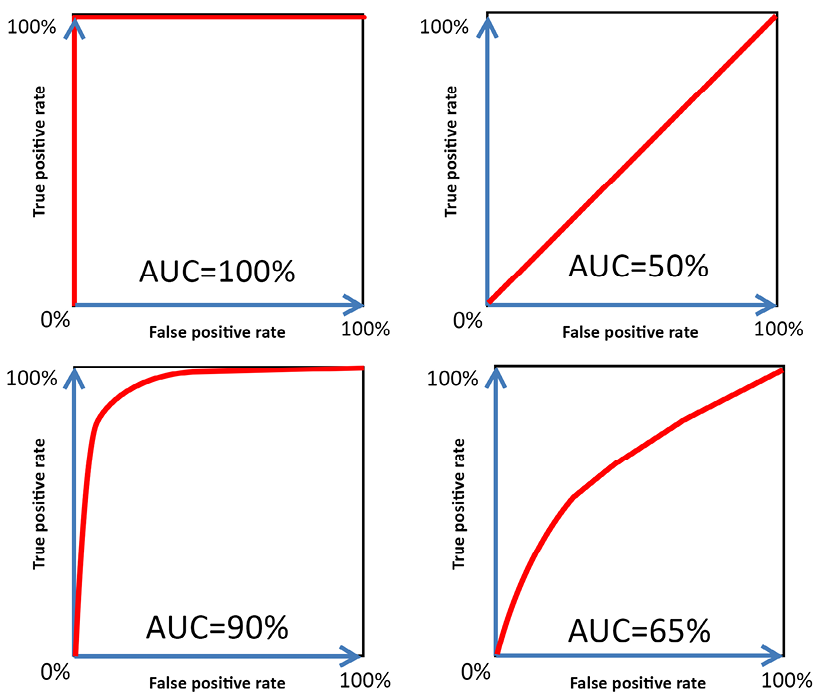 图片
图片
理想情况下,性能良好的分类器的 ROC 曲线应该在假阳性率较低时攀升真阳性率(召回率)。因此,0.9–1 之间的 ROC 非常好。
坏分类器是与图表对角线相似或相同的分类器,代表纯随机分类器的性能。
如果类别平衡,你可以认为更高的 AUC == 模型能够输出更高概率的真阳性结果。但是,如果阳性结果很少见,AUC 一开始就很高,增量对于更好地预测罕见类别可能意义不大。平均精度在这里将是一个更有用的指标。
加载数据
我们加载给定的生成数据,以及深度学习模型训练的原始数据集。
train = pd.read_csv("./data/train.csv") # 数据获取:在公众号:数据STUDIO 后台回复240720 获取
original = pd.read_csv("./data/Churn_Modelling.csv")
test = pd.read_csv("./data/test.csv")
train.drop(columns=["id"], inplace=True)
test.drop(columns=["id"], inplace=True)
original.drop(columns=["RowNumber"], inplace=True)
train = pd.concat([train, original.dropna()], axis=0)
train.reset_index(inplace=True, drop=True)
target_col = "Exited"探索性数据分析
我们有 175k 个数据点可供使用。
train.info()<class 'pandas.core.frame.DataFrame'>
Index: 175030 entries, 0 to 175030
Data columns (total 13 columns):
# Column Non-Null Count Dtype
--- ------ -------------- -----
0 CustomerId 175030 non-null int32
1 Surname 175030 non-null object
2 CreditScore 175030 non-null int16
3 Geography 175030 non-null object
4 Gender 175030 non-null object
5 Age 175030 non-null float16
6 Tenure 175030 non-null int8
7 Balance 175030 non-null float32
8 NumOfProducts 175030 non-null int8
9 HasCrCard 175030 non-null float16
10 IsActiveMember 175030 non-null float16
11 EstimatedSalary 175030 non-null float32
12 Exited 175030 non-null int8
dtypes: float16(3), float32(2), int16(1), int32(1), int8(3), object(3)
memory usage: 9.2+ MB减少数据集的内存,以便特征工程和建模更加节省内存。
train = reduce_mem_usage(train)Mem. usage decreased to 9.18 Mb (50.9% reduction)这是一个使用prettytable打印数据集中缺失数据的好函数
看来我们的数据没有缺失值。
print_missing_table(train, test, target_col)+-----------------+-----------+-----------------+----------------+
| Feature | Data Type | Train Missing % | Test Missing % |
+-----------------+-----------+-----------------+----------------+
| CustomerId | int64 | 0.0 | 0.0 |
| Surname | object | 0.0 | 0.0 |
| CreditScore | int64 | 0.0 | 0.0 |
| Geography | object | 0.0 | 0.0 |
| Gender | object | 0.0 | 0.0 |
| Age | float64 | 0.0 | 0.0 |
| Tenure | int64 | 0.0 | 0.0 |
| Balance | float64 | 0.0 | 0.0 |
| NumOfProducts | int64 | 0.0 | 0.0 |
| HasCrCard | float64 | 0.0 | 0.0 |
| IsActiveMember | float64 | 0.0 | 0.0 |
| EstimatedSalary | float64 | 0.0 | 0.0 |
| Exited | int64 | 0.0 | NA |
+-----------------+-----------+-----------------+----------------+以下是我们的数据。
train.head() 图片
图片
为了简单起见,我们过滤掉分类或连续的列。
# 每列的唯一值计数
unique_counts = train.nunique()
# 区分连续和分类的阈值
threshold = 12
# 连续变量只选择数字列
numeric_cols = train.select_dtypes(include=[np.number]).columns.tolist()
continuous_vars = unique_counts[(unique_counts > threshold) & unique_counts.index.isin(numeric_cols)].index.tolist()
categorical_vars = unique_counts[(unique_counts <= threshold) | ~unique_counts.index.isin(numeric_cols)].index.tolist()
target_col = 'Exited'
id_col = ['id', 'CustomerId']
if target_col in categorical_vars:
categorical_vars.remove(target_col)
for col in id_col:
if col in continuous_vars:
continuous_vars.remove(col)
print(f"Categorical Variables: {categorical_vars}")
print(f"Continuous/Numerical Variables: {continuous_vars}")Categorical Variables: ['Surname', 'Geography', 'Gender', 'Tenure', 'NumOfProducts', 'HasCrCard', 'IsActiveMember']
Continuous/Numerical Variables: ['CreditScore', 'Age', 'Balance', 'EstimatedSalary']绘制出target。
plot_categorical(train, column_name='Exited')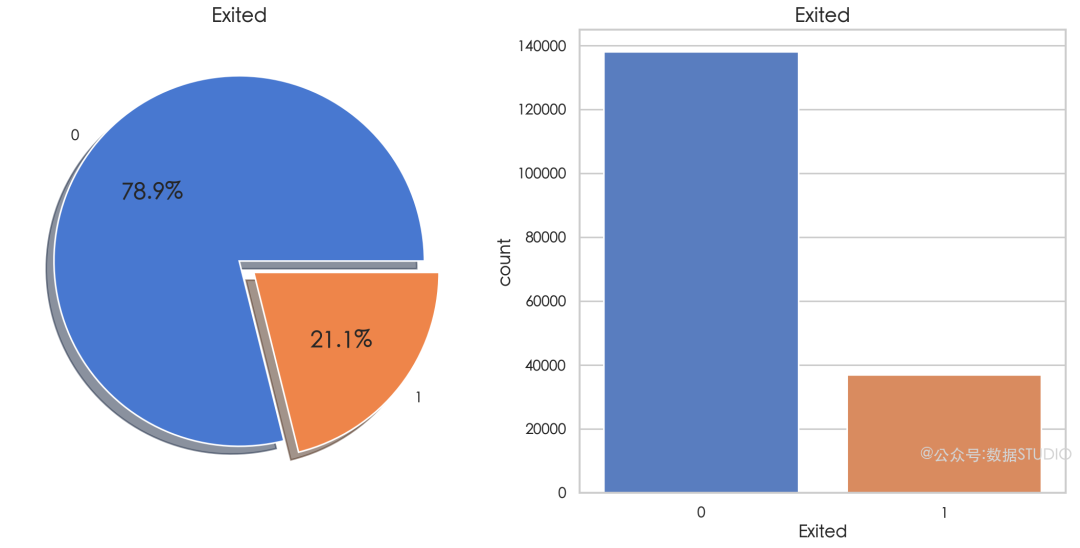 图片
图片
这里存在明显的类别不平衡。只有 20% 的数据属于正类:Exited = 1
接下来我们看看连续变量和目标列的相互作用。
plot_violin_plots(train, continuous_vars, target_col)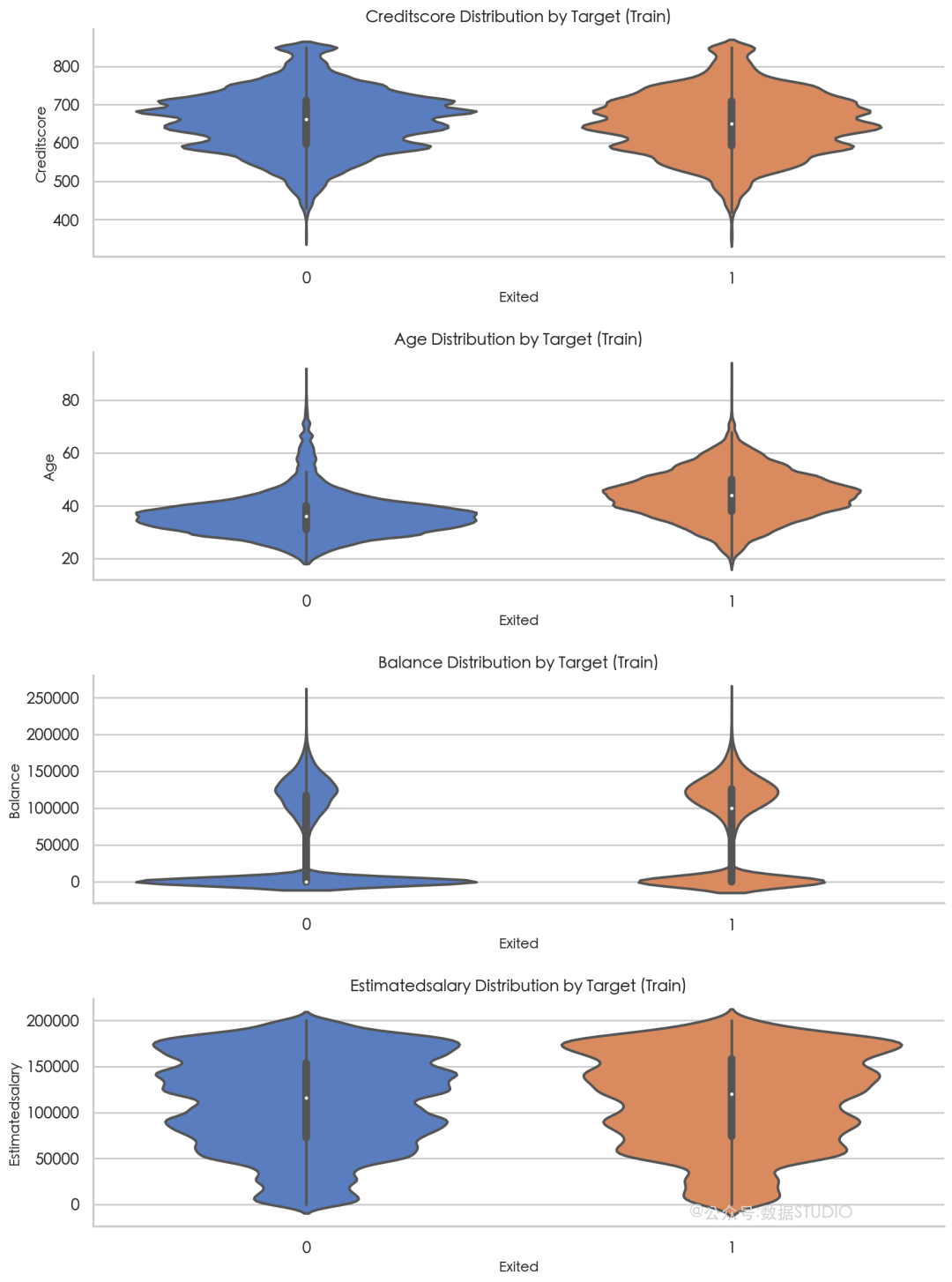 图片
图片
退出的客户的中位数age(1) 似乎高于未退出的客户的中位数 (0) 退出值之间的差异,这表明它可能是预测退出的相关因素。
分布balance表明,未退出的客户(0)在 0 左右集中度较大,而退出的客户(1)的中位数余额较高。
plot_histograms(train, continuous_vars, target_col) 图片
图片
 图片
图片
 图片
图片
 图片
图片
我们观察到大量未退出的年轻客户,而退出客户的分布则偏向于老年。这一点在 50 岁左右的峰值中尤为明显,此时橙线超过了蓝线。
plot_correlation_heatmap(train, continuous_vars, target_col)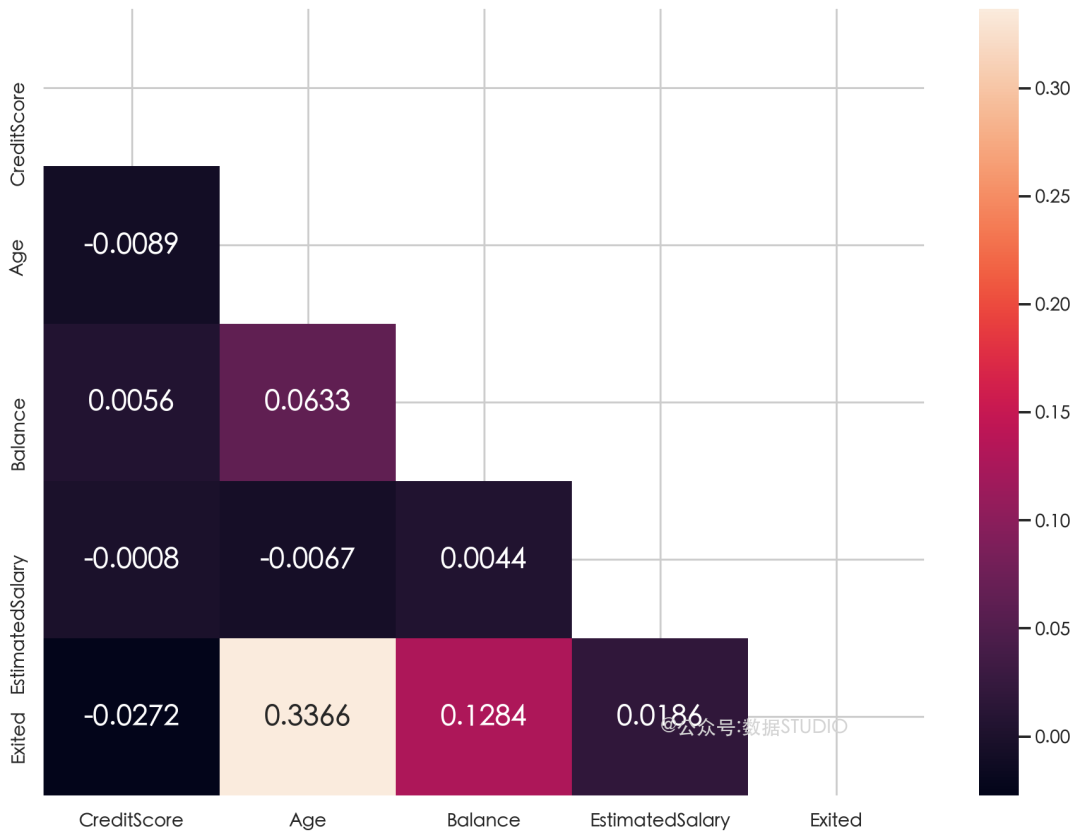 图片
图片
“Age”和“Exited”之间呈现出最强的正相关性(0.3366),这支持了年龄是预测客户流失的重要因素这一发现
“Balance”也与“Exited”呈现正相关(0.1284),表明余额较高的客户更有可能离开。
plot_pairplot(train, continuous_vars, target_col)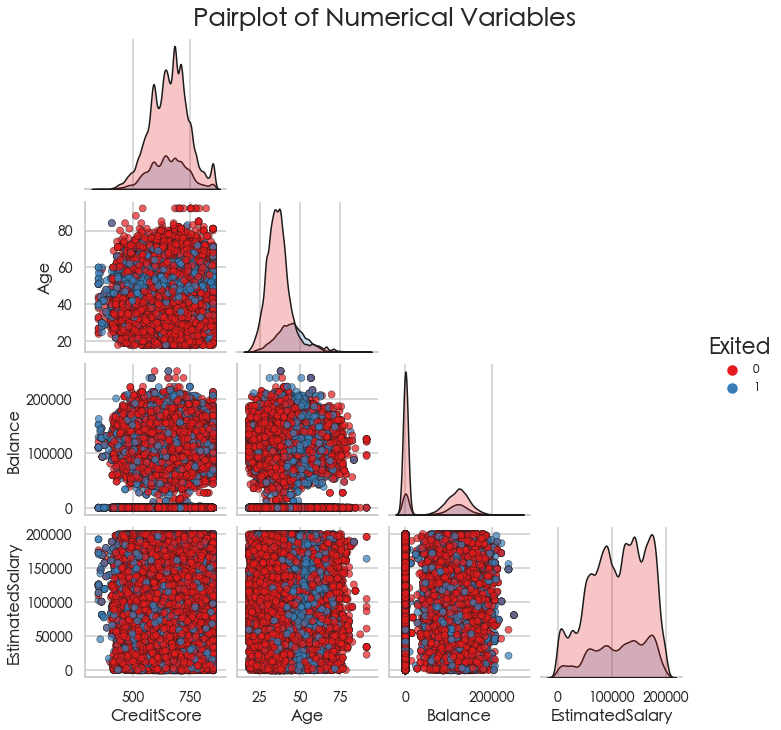 图片
图片
这两个类别之间没有明显的区分,这表明单个变量不足以区分退出的顾客和未退出的顾客。
特征工程
现在是时候创建一些特征了。每当你得到数据时,你都可以创建更多特征来提高模型的预测能力。这就像从数据中榨取每一点洞察力一样。
为此,我们将构建一个管道,它是对一组数据进行操作的对象序列。操作可以包括:
- 关系探索
- 特征变换
- 处理缺失值
- 创建新特征
- 选择适合模型
- 预测未知数据
这是一个简单的转换器示例,仅用于删除列
class DropColumn(BaseEstimator, TransformerMixin):
def __init__(self, cols):
self.cols = cols
def fit(self, X, y=None):
return self
def transform(self, X):
return X.drop(self.cols, axis=1)另一个用于一次性执行 kmeans 聚类、缩放和 PCA。
from sklearn.preprocessing import StandardScaler
from sklearn.decomposition import PCA
from sklearn.cluster import KMeans
class KMeansClusterer(BaseEstimator, TransformerMixin):
def __init__(self, features, n_clusters=20, random_state=0, n_compnotallow=None):
self.features = features
self.n_clusters = n_clusters
self.random_state = random_state
self.n_components = n_components
self.kmeans = KMeans(n_clusters=n_clusters, n_init=50, random_state=random_state)
self.scaler = StandardScaler()
self.pca = PCA(n_compnotallow=n_components)
def fit(self, X, y=None):
X_scaled = self.scaler.fit_transform(X.loc[:, self.features])
if self.n_components is not None:
X_scaled = self.pca.fit_transform(X_scaled)
self.kmeans.fit(X_scaled)
return self
def transform(self, X):
X_scaled = self.scaler.transform(X.loc[:, self.features])
# check for NaN and replace with zero
if np.isnan(X_scaled).any():
X_scaled = np.nan_to_num(X_scaled)
if self.n_components is not None:
X_scaled = self.pca.transform(X_scaled)
X_new = pd.DataFrame()
X_new["Cluster"] = self.kmeans.predict(X_scaled)
X_copy = X.copy()
# convert to dense format
X_new["Cluster"] = X_new["Cluster"].values
return pd.concat([X_copy.reset_index(drop=True), X_new.reset_index(drop=True)], axis=1)
clusterer_with_pca = KMeansClusterer(features=["CustomerId","EstimatedSalary","Balance"], n_clusters=10, random_state=123, n_compnotallow=3)
clusterer_with_pca.fit_transform(train)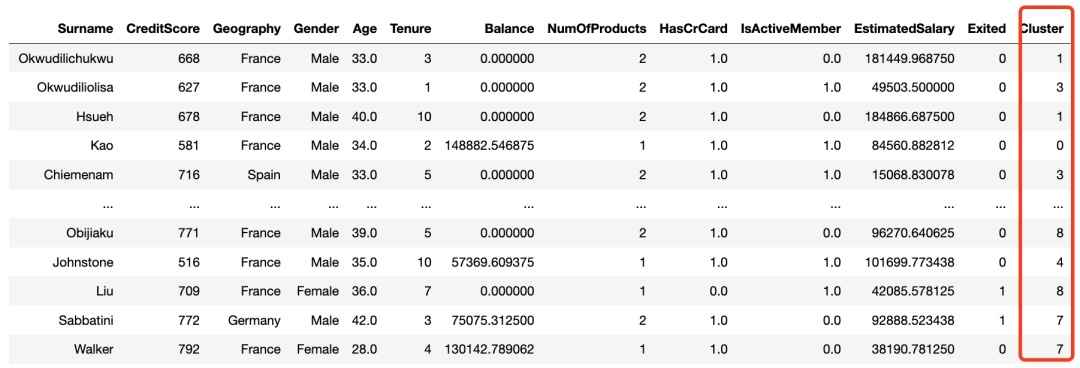 图片
图片
一旦定义了构建新功能和执行某些转换所需的所有转换器,就可以构建管道了。因篇幅限制,所有转换器构建的完整代码可以在@公众号:数据STUDIO 后台回复 240720 即可免费获取完整代码。
对于编码,你需要使用列转换器。我们将输出设置为 pandas。
from sklearn.pipeline import Pipeline
from sklearn.compose import ColumnTransformer
from sklearn.preprocessing import OneHotEncoder
preprocessing_pipeline = Pipeline([
('kmeans', KMeansClusterer(features=["CustomerId", "EstimatedSalary", "Balance"], n_clusters=10, random_state=123, n_compnotallow=3)),
('surname_tfid', TFIDFTransformer(column="Surname", max_features=1000, n_compnotallow=5)),
('age_binning', VariableBinning(n_bins=5, column_name="Age")),
('salary_binning', VariableBinning(n_bins=10, column_name="EstimatedSalary")),
('balance_salary_ratio', BalanceSalaryRatioTransformer()),
('geo_gender', GeoGenderTransformer()),
('total_products', BalanceSalaryRatioTransformer()), # Note: Should be TotalProductsTransformer, but not defined above
('tp_gender', TpGenderTransformer()),
('is_senior', IsSeniorTransformer()),
('quality_of_balance', QualityOfBalanceTransformer()),
('credit_score_tier', CreditScoreTierTransformer()),
('is_active_by_credit_card', IsActiveByCreditCardTransformer()),
('products_per_tenure', ProductsPerTenureTransformer()),
('customer_status', CustomerStatusTransformer()),
('drop', DropColumn(cols=['CustomerId', 'Surname'])),
('prep', ColumnTransformer([
('encode', OneHotEncoder(handle_unknown='ignore', sparse_output=False),
['Gender', 'Geography', 'NumOfProducts', 'HasCrCard', 'IsActiveMember', 'Geo_Gender', 'Tp_Gender']),
],
remainder='passthrough').set_output(transform='pandas')),
])
preprocessing_pipeline 图片
图片
将这个管道应用到我们的训练数据集上。
df_train = preprocessing_pipeline.fit_transform(train.drop(['Exited'], axis=1))
df_train.info()<class 'pandas.core.frame.DataFrame'>
RangeIndex: 175030 entries, 0 to 175029
Data columns (total 49 columns):
# Column Non-Null Count Dtype
--- ------ -------------- -----
0 encode__Gender_Female 175030 non-null float64
1 encode__Gender_Male 175030 non-null float64
2 encode__Geography_France 175030 non-null float64
3 encode__Geography_Germany 175030 non-null float64
4 encode__Geography_Spain 175030 non-null float64
5 encode__NumOfProducts_1 175030 non-null float64
6 encode__NumOfProducts_2 175030 non-null float64
7 encode__NumOfProducts_3 175030 non-null float64
8 encode__NumOfProducts_4 175030 non-null float64
9 encode__HasCrCard_0.0 175030 non-null float64
10 encode__HasCrCard_1.0 175030 non-null float64
11 encode__IsActiveMember_0.0 175030 non-null float64
12 encode__IsActiveMember_1.0 175030 non-null float64
13 encode__Geo_Gender_France_Female 175030 non-null float64
14 encode__Geo_Gender_France_Male 175030 non-null float64
15 encode__Geo_Gender_Germany_Female 175030 non-null float64
16 encode__Geo_Gender_Germany_Male 175030 non-null float64
17 encode__Geo_Gender_Spain_Female 175030 non-null float64
18 encode__Geo_Gender_Spain_Male 175030 non-null float64
19 encode__Tp_Gender_1.0Female 175030 non-null float64
20 encode__Tp_Gender_1.0Male 175030 non-null float64
21 encode__Tp_Gender_2.0Female 175030 non-null float64
22 encode__Tp_Gender_2.0Male 175030 non-null float64
23 encode__Tp_Gender_3.0Female 175030 non-null float64
24 encode__Tp_Gender_3.0Male 175030 non-null float64
25 encode__Tp_Gender_4.0Female 175030 non-null float64
26 encode__Tp_Gender_4.0Male 175030 non-null float64
27 encode__Tp_Gender_5.0Female 175030 non-null float64
28 encode__Tp_Gender_5.0Male 175030 non-null float64
29 remainder__CreditScore 175030 non-null int16
30 remainder__Age 175030 non-null float32
31 remainder__Tenure 175030 non-null int8
32 remainder__Balance 175030 non-null float32
33 remainder__EstimatedSalary 175030 non-null float32
34 remainder__Cluster 175030 non-null int32
35 remainder__Surname_tfidf_0 175030 non-null float64
36 remainder__Surname_tfidf_1 175030 non-null float64
37 remainder__Surname_tfidf_2 175030 non-null float64
38 remainder__Surname_tfidf_3 175030 non-null float64
39 remainder__Surname_tfidf_4 175030 non-null float64
40 remainder__QCut5_Age 175030 non-null int64
41 remainder__QCut10_EstimatedSalary 175030 non-null int64
42 remainder__Total_Products_Used 175030 non-null float16
43 remainder__IsSenior 175030 non-null int64
44 remainder__QualityOfBalance 175030 non-null category
45 remainder__CreditScoreTier 175030 non-null category
46 remainder__IsActive_by_CreditCard 175030 non-null float16
47 remainder__Products_Per_Tenure 175030 non-null float64
48 remainder__Customer_Status 175030 non-null int64
dtypes: category(2), float16(2), float32(3), float64(35), int16(1), int32(1), int64(4), int8(1)
memory usage: 56.3 MB从 14 个特征增加到现在 48 个!
GBT 分类器
我们将训练以下增强模型:XGBoost、Catboost、LightGBM。
我们使用Optuna来找到此 Catboost 分类器的最佳超参数。我设置n_trials=10它是为了让它完成得更快,如果你时间充足,这里可以设置大一点(越大时间越久)。
其余模型的构建完整代码:可以在@公众号:数据STUDIO 后台回复 240720 即可免费获取完整代码。
# 过滤警告 (FutureWarnings)
warnings.filterwarnings("ignore",
category=FutureWarning,
module="sklearn.utils.validation")
skf = StratifiedKFold(n_splits=10, shuffle=True, random_state=42)
def objective(trial):
params = {
'iterations': trial.suggest_int('iterations', 500, 1000),
'depth': trial.suggest_int('depth', 10, 16),
'min_data_in_leaf': trial.suggest_int('min_data_in_leaf', 2, 20),
'learning_rate': trial.suggest_float('learning_rate', 1e-4, 0.2, log=True),
}
cb_model = CatBoostClassifier(**params, random_state=42, grow_policy='Lossguide', verbose=0)
cb_pipeline = make_pipeline(modelling_pipeline, cb_model)
cv = abs(cross_val_score(cb_pipeline, X, y, cv=skf, scoring='roc_auc').mean())
return cv
study = optuna.create_study(directinotallow='maximize')
study.optimize(objective, n_trials=10)
best_params_cb = study.best_params
print("Best Hyperparameters for CatBoost:", best_params_cb)完成后,你可以将最佳参数传递给分类器。
cb_model = CatBoostClassifier(**best_params_cb, random_state=42, verbose=0)
cb_pipeline_optimized = make_pipeline(modelling_pipeline, cb_model)我们再进行一次 KFold 来检查 AUC 分数。
n_splits = 10
stratkf = StratifiedKFold(n_splits=n_splits, shuffle=True, random_state=42)
cv_results = []
for fold, (train_idx, val_idx) in enumerate(stratkf.split(X, y)):
X_train, X_val = X.iloc[train_idx], X.iloc[val_idx]
y_train, y_val = y.iloc[train_idx], y.iloc[val_idx]
cb_pipeline_optimized.fit(X_train, y_train)
y_val_pred_prob = cb_pipeline_optimized.predict_proba(X_val)[:, 1]
y_pred = cb_pipeline_optimized.predict(X_val)
f1 = f1_score(y_val, y_pred, average='weighted')
# Evaluating the model
logloss = log_loss(y_val, y_val_pred_prob)
roc_auc = roc_auc_score(y_val, y_val_pred_prob)
print(f'Fold {fold + 1}, AUC-Score on Validation Set: {roc_auc}')
print(f'Fold {fold + 1}, F1 Score on Validation Set: {f1}')
print(f'Fold {fold + 1}, Log Loss Score on Validation Set: {logloss}')
print('-'*70)
cv_results.append(logloss)
average_cv_result = sum(cv_results) / n_splits
print(f'\nAverage Logarithmic Loss across {n_splits} folds: {average_cv_result}')我们可以使用混淆矩阵检查模型的性能。
X_train, X_val, y_train, y_val = train_test_split(X, y, test_size=0.2, random_state=42)
cb_pipeline_optimized.fit(X = X_train,
y = y_train)
predictions_cb = cb_pipeline_optimized.predict(X_val)
cm_cb = confusion_matrix(y_val, predictions_cb)
disp = ConfusionMatrixDisplay(confusion_matrix=cm_cb, display_labels=['Not Churn', 'Churn'])
disp.plot()
plt.show()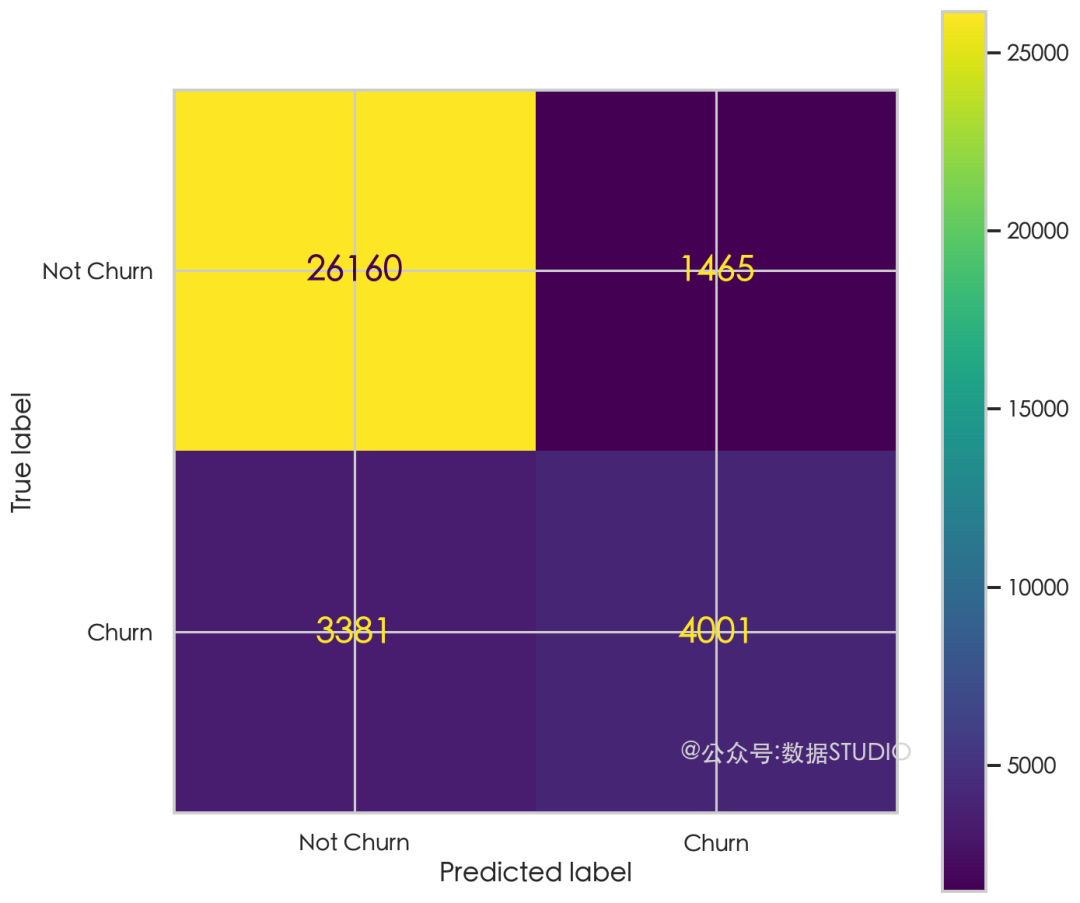 图片
图片
我们的模型具有较高的真阴性率,这意味着它在识别不会流失的客户方面比识别会流失的客户更有效。模型预测不会流失的客户中,有相当一部分实际上流失了,这可能是一个需要改进的领域。减少假阴性可以帮助公司更有效地采取干预措施来留住客户。
我们还可以看到 catboost 分类器的特征重要性。
cb_feature_importance = cb_pipeline_optimized.named_steps['catboostclassifier'].feature_importances_
sorted_idx = np.argsort(cb_feature_importance)
fig = plt.figure(figsize=(18, 16))
plt.barh(range(len(sorted_idx)), cb_feature_importance[sorted_idx], align='center')
plt.yticks(range(len(sorted_idx)), np.array(train_X.columns)[sorted_idx])
plt.title('CB_Feature Importance')
plt.show()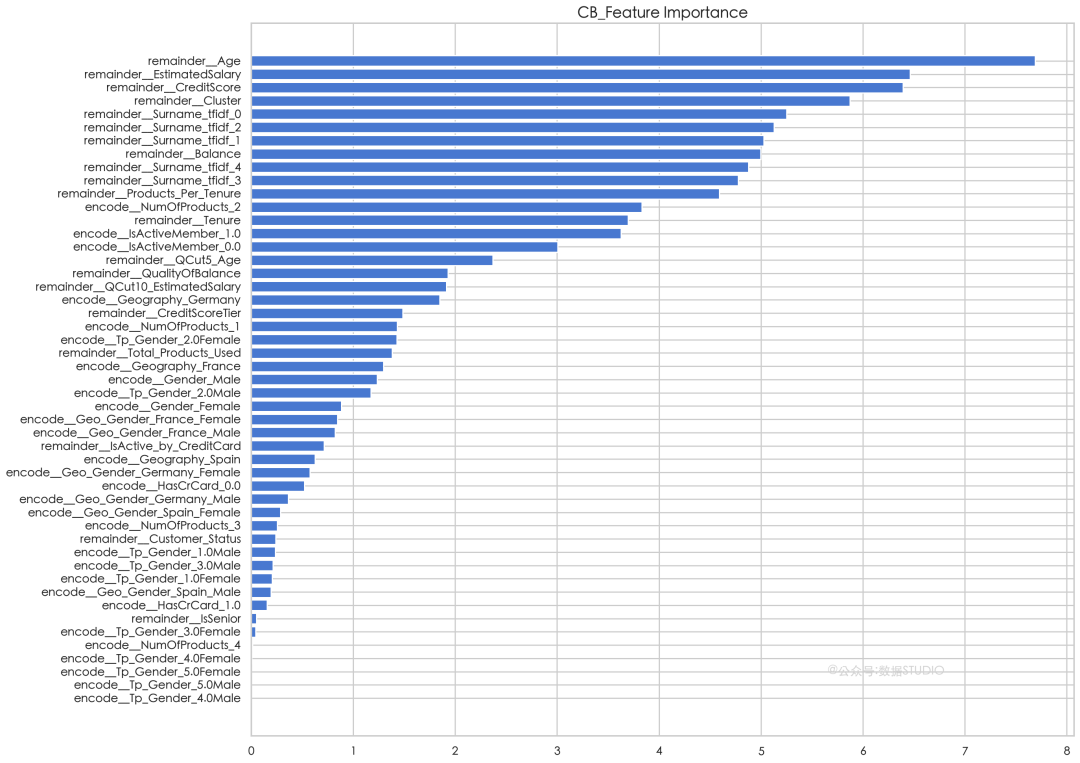 图片
图片
图表显示,对于模型的预测来说,最重要的特征包括年龄、信用评分、估计工资和集群。姓氏的 tfidf 特征似乎也与预测特征重要性有关,尽管这可能会导致对这些名字的过度拟合。
集成学习
现在有性能各异的不同模型。通过集成学习,可以将这些模型融合在一起,以实现更高的性能!
这里我们使用带有“软”投票的投票分类器,它根据预测概率总和的 argmax 来预测类标签。
这些权重是一个数字,它告诉分类器在平均之前对类概率赋予多大的重要性(权重)。它们也可以使用 GridSearch 或 Optuna 进行优化。
ensemble_model = VotingClassifier(estimators=[
('xgb', xgb_pipeline_optimized),
('lgb', lgb_pipeline_optimized),
('cb', cb_pipeline_optimized)
], voting='soft', weights = [0.4,0.4,0.2])
ensemble_modelX_train, X_val, y_train, y_val = train_test_split(X, y, test_size=0.2, random_state=42)
ensemble_model.fit(X = X_train, y = y_train)
predictions_ensemble = ensemble_model.predict(X_val)
cm_ensemble = confusion_matrix(y_val, predictions_ensemble)
disp = ConfusionMatrixDisplay(confusion_matrix=cm_ensemble, display_labels=['Not Churn', 'Churn'])
disp.plot()
plt.show()请注意,我们的假阴性略有减少,而真阳性有所增加。


































